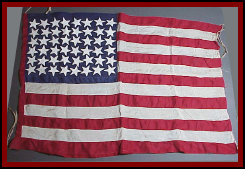













Thank you for your continued support and readership. Please insure to forward this Newsletter to your friends and neighbors. If you no longer wish to receive our emails regarding the update of this page, please send us an email to info@nova-antiques.com with the subject line "OPT OUT"
NOVA-Antiques.com does not run, manage or operate any of the flea markets, auction houses or estate sale companies advertised on this page. The NOVA-Antiques Newsletter is published for the exclusive use, enjoyment and convenience of our readers and subscribers. Any questions regarding the flea markets, auction houses and estate sale companies should be directed to the appropriate owner, promoter or manager.
Brief History of the Tea Caddy
Ahhh . . . a refreshing cup of tea. The same tea that the patriots dumped into the Boston Harbor
was introduced to the English from China in the mid 1600’s. Believed to be a healing drink by its early connoisseurs, tea was
originally for the well to do because of its extremely high price. Tea was packaged and imported in large quantities and the
tax man then levied heavy taxes on the shipments. Tea remained very expensive for about 100 years, until many people started
buying the tea illegally from the black market. Because tea was associated with the mighty and powerful, it had to be stored
in only the best boxes or what was known as the tea caddy.


Mikey was feeling a bit overweight so he paid a visit to his doctor. The doctor told him, “Well, Mikey
follow these directions and I guarantee you will lose at least 5 pounds by the next time I see you.” Mikey was very enthusiastic,
“Sure Doc, anything, anything just tell me.” So the doctor told him, “I want you to eat regularly for two days then skip a day. Repeat this procedure for two weeks and then come back and see me.”




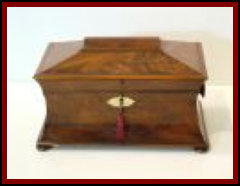
Upcoming Antique Shows & Flea Markets
NOVA-Antiques.com provides the most comprehensive antiques show and flea market calendar
for the Mid Atlantic region.
Click here to view the most current antiques and collectibles shows calendar . . . > > >
Click here to view our flea
market directory and review pages . . . > > >
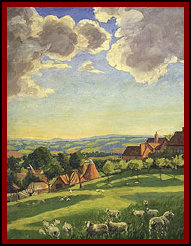

The painting, which he painted in the early 1940’s, was of his Chartwell estate in Kent. Measuring 76” x 63.5”, this painting
was originally given to his friend Henry Luce, an American publisher and is titled, “Cartwell: Landscape with Sheep.” Mr. Churchill’s
paintings have more than doubled in price in the last ten years.

The word caddy is from Malaysia and was a unit of measure equal to about 3/5 of a kilo. In the early 1700’s a lot of tea caddies
were made of wood in very intricate design, many featuring tortoiseshell and ivory. These boxes were shaped like small chests
and some were even carved in the Chippendale style. These early boxes are very rare and collectible today. In the 1800’s
the tea caddies began to take different shapes, with influences coming from both China and Egypt. Many of the tea caddies from
this era featured pagoda tops and tapered sides as well a concave and other linear combinations.


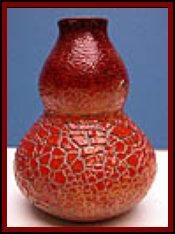
So off Mikey goes and follows the doctor’s direction. When he returns in two weeks he has lost an astonishing 20 pounds. “That’s amazing,” says the doctor, “Did you follow my instructions?” Mikey says, “yeah Doc, but on the third day I thought I
was going to die.” “From hunger?” asks the doctor. “No,” says Mikey, “From all the skipping.”
Collecting Early American Flags
Have you ever been to an auction or estate sale and seen an early American flag? If you are as
patriotic as we are, we wish to buy the flag to display in or around our home. However, we do not know much about early American
flags . . . that is until now. Jeff Bridgman wrote an article for Country Home Magazine that gives ten tips for selecting an
Early American flag. Here is an excerpt from that article which can be found on his website.
1. Start small and be cautious. Ask a lot of questions.
2. Read as much as possible and look
at as many examples as possible.
3. Know the difference between sewn flags and parade flags.
4. If buying a sewn flag, buy a large one, it will save you money.
5. Know the construction method. By the turn
of the century hand sewn flags had all but disappeared.
6. Don’t get hung up on the condition of the flag since most
were used outdoors.
7. Treat the flag as objects of art as well as history.
8. Limit your collection to
a particular interest.
9. Conserve your flag properly.
10. Never discard or burn early American flags.


The Lucketts Fair will take place on Saturday and Sunday, August 25 & 26, 2007 and will be celebrating its 35th
year. This Fair not only features some great antiques and collectibles, but also has many different crafters displaying their
wares as well as great entertainment, demonstrations, food and fun stuff for the entire family. The scenic village of Lucketts
is located in Loudoun County Virginia on Route 15 north.
Miklos Zsolnay founded his company in Hungary in the mid 19th Century and was instrumental in the invention
of many different processes in the production of ceramics. Initially dealing in stoneware and earthenware, the company is now
better known for its art pottery and other ceramic goods. In the early 1900’s the company embraced the Art Nouveau style and
achieved world acclaim for its art pottery pieces.
Early vases were made in an hourglass figure shape that resembled the women of the time with very thin waists and bulging bottoms. The most prized vases are those made from a red iridescent glaze and the gold lustre vases that the company is most famous for. These “eosin” glazed pieces were named after Eos the ancient Green goddess of the dawn. Other colors in this type of glaze (green
and blue) are easier to find and more reasonably priced.
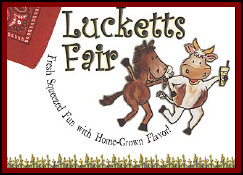
Record Auction Price for Winston Churchill Painting (2007)
The British Prime Minister, Sir Winston Churchill was not only a great statesman
but a pretty darn good artist too. Sotheby’s of England recently announced that a painting by the Great War time Prime Minister
of England sold for a record auction price of just over $2 million.
Recent Estate Sale Find; Northwood Glass Bowl
This lovely large green opalescent glass bowl was made by the Northwood Glass Company
in the Meander pattern. This fancy bowl features a deep crimped, opalescent ruffled rim, measures 9” across and stands 3.5 inches
tall on three spatula feet. This pattern was first produced by the Jefferson Glass Company at the turn of the century, then Northwood
in the early 1900’s. Later still, the molds and pattern were sold to the Fenton Glass Company, who made the same bowls in iridescent
or carnival glass. The bowl is listed in Edwards Standard Encyclopedia of Opalescent Glass Second Edition.